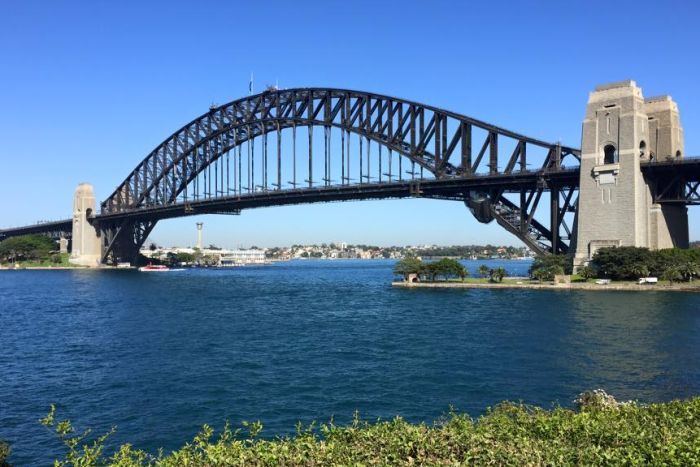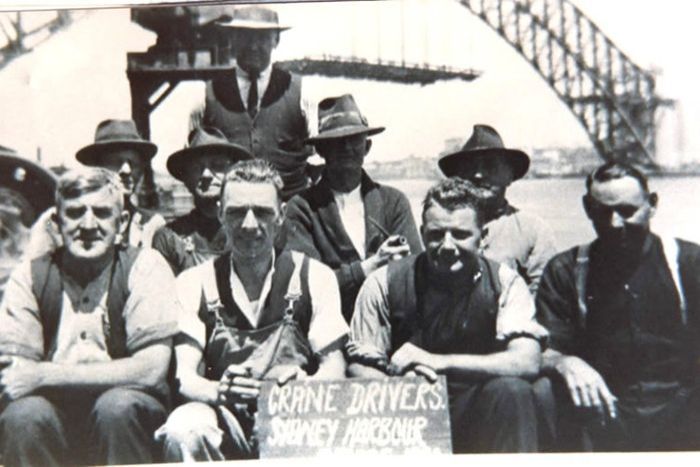Sydney Harbour Bridge celebrates 85th birthday with release of archival footage and worker interviews
Posted
 Photo:
The Sydney Harbour Bridge, one of the city's iconic landmarks. (ABC Radio Sydney: Lawrence Champness)
Photo:
The Sydney Harbour Bridge, one of the city's iconic landmarks. (ABC Radio Sydney: Lawrence Champness)
Over the years the Sydney Harbour Bridge has been fondly described as the coat hanger, a symphony of steel, the arch that closed the sky — even the humpback whale.
The Queen Mother said it was "one of the wonders of our time".
But of all the nicknames Sydney's iconic landmark received in the past 85 years, the Iron Lung is one that echoes its significance for those who built it.
The construction employed 1,400 builders who were paid as little as four pounds a week at the height of the Great Depression.
More than 200 families living in the far New South Wales south coast town of Moruya were able to put food on their tables because they worked out of the quarries which provided the granite for the bridge pylons.
With the rest of the country struggling under hardship, bridge workers at the time were recorded saying that they were grateful for the work.
"There was guilt; either stop on the job or go back on the dole," labourer Pat Crawley said at the time.
"[Working conditions] were pretty crude. There weren't many amenities.
"Everywhere was rough in them days."
Crawley was just one of hundreds of interviews recorded and this year released by the State Library of NSW to mark the bridge's 85th birthday.
There are 13,000 hours of digital sound recordings.
The National Film and Sound Archive of Australia has also released a new online exhibition with video footage of the bridge's construction and opening.
A bridge of accidents
The Sydney Harbour Bridge officially opened on March 19, 1932.
Construction started in 1923 but it had taken about a century to get to that stage.
 Photo:
Crane drivers for the construction of the Sydney Harbour Bridge. (Meryl Thomas: user submitted)
Photo:
Crane drivers for the construction of the Sydney Harbour Bridge. (Meryl Thomas: user submitted)
"The first idea of a crossing of the Harbour was when Francis Greenway mooted that it would be fantastic to have some kind of crossing in 1815," Anni Turnbull, State Library of NSW curator, told ABC Radio Sydney.
"It took over 100 years of debate about what it would look like, who would pay for it, would it be a bridge or a tunnel."
Once construction started, Ms Turnbull said, the occupation, health and safety conditions were in no way like those today.
Fourteen people died from the bridge and another two in the Moruya quarries.
Apprentices used to get across the arches by climbing up the jibs of the creeper cranes or via ladders, according to some of the interviews.
Harry Vasiere, a rivet catcher in the Milson's Point workshops, was recorded with a story about an accident off site:
"The only time I put the wind up the wife: In between two girders they were painting them in red lead.
"One bloke handed it over to the other and the handle broke and I caught the whole lot.
"When I got home, because I was covered, my wife thought I'd had a serious accident with all the red."
His memory of the opening of the bridge, though, was one he recalled with fondness.
"I went down to Sydney for the opening of the bridge and walked across it with the wife.
"Oh yes, we had a good day down there that day."
The historic interviews can be heard via the State Library's Bridge Builders collection.
Topics: history, community-and-society, human-interest, sydney-2000









